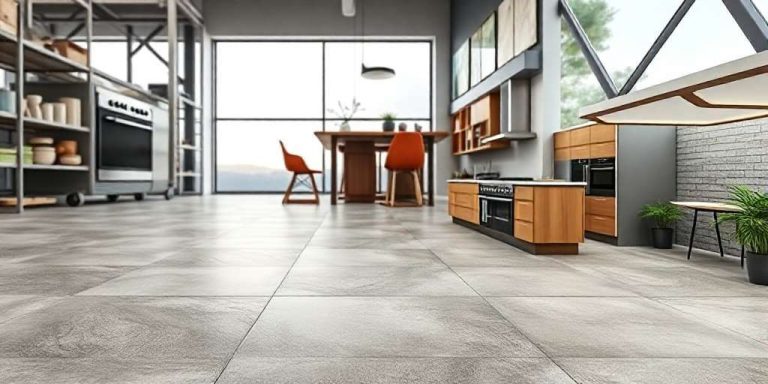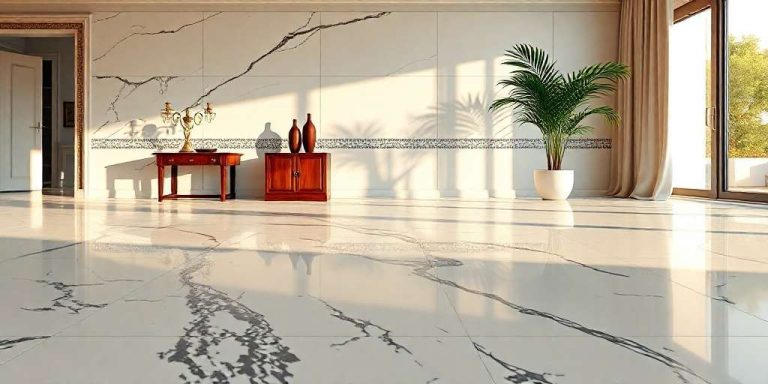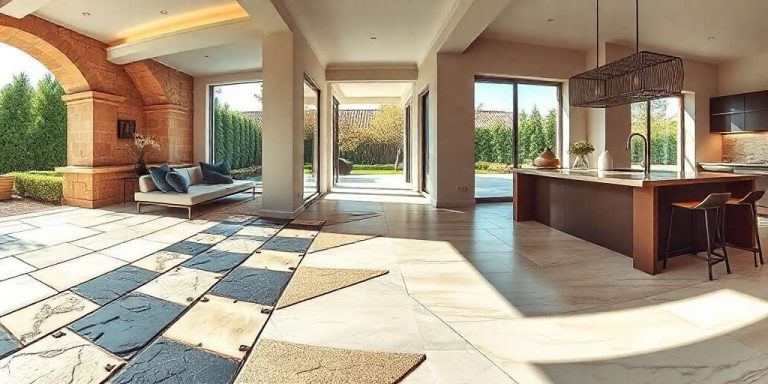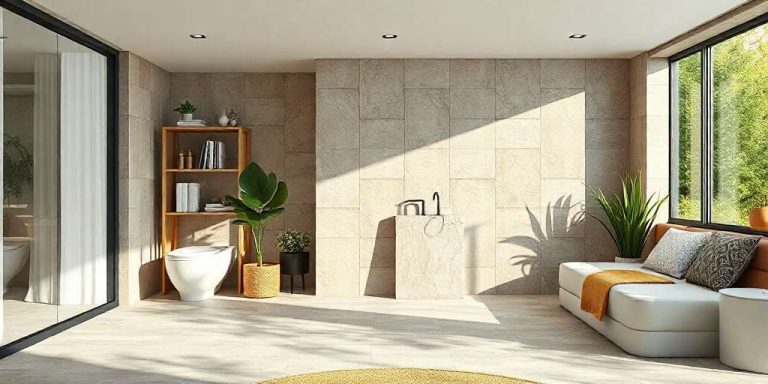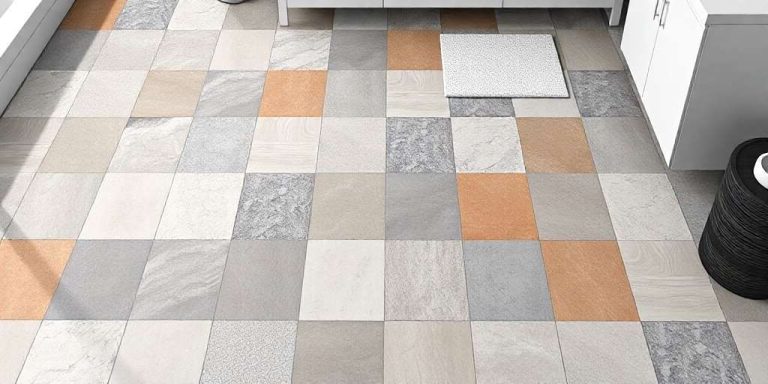Kitchen Floor Tiles: The Best Options for Every Style and Need
Kitchen floor tiles are essential for enhancing both the look and functionality of a kitchen. There are various materials and styles available, allowing homeowners to find the perfect fit for their needs. Ceramic and porcelain tiles are the most popular choices. Each type offers distinct advantages such as durability, moisture resistance, and a wide range of decorative options. Selecting the right tiles contributes significantly to the overall kitchen design.
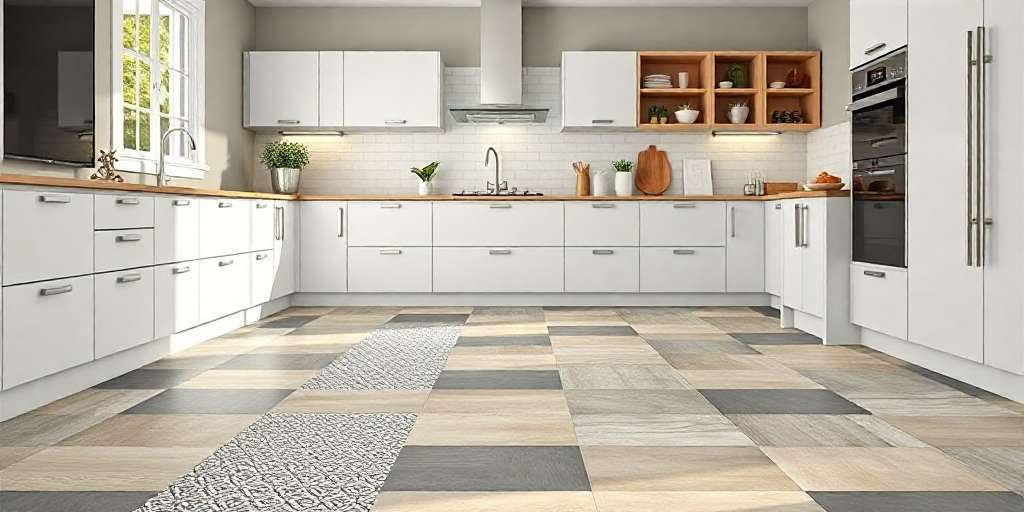
Understanding Kitchen Floor Tiles: Key Materials and Features
Choosing the right materials for kitchen flooring is crucial for achieving both durability and a pleasing aesthetic. Two of the most popular options are ceramic and porcelain tiles, each offering unique features and advantages.
Ceramic Tiles for Kitchens
Ceramic tiles have long been a staple in kitchen design, known for their affordability and versatility. Made from clay and fired in a kiln, they are available in a variety of colors and patterns, making them a suitable choice for most kitchen styles.
Durability and Maintenance of Ceramic Tiles
The durability of ceramic tiles makes them ideal for high-traffic areas, as they can withstand heavy footfall without significant wear. However, they may require more maintenance than porcelain tiles. Regular cleaning with a non-abrasive detergent helps keep them looking their best. Furthermore, sealing the grout lines can prevent staining and moisture intrusion.
Decorative Options and Styles in Ceramic
The aesthetic appeal of ceramic tiles lies in their vast array of designs. Homeowners can choose from traditional or modern styles, including vibrant tiles that add character or muted tones that create a contemporary feel. Specialty tiles can also replicate the appearance of natural stones or wood, allowing for creative design flexibility.
Porcelain Tiles: The Premium Kitchen Flooring Choice
For those seeking a high-end option, porcelain tiles stand out as the premium choice for kitchen flooring. Crafted from more refined clays and fired at higher temperatures, they deliver superior durability and style.
Resistance and Water Absorption Benefits
One of the significant advantages of porcelain tiles is their low water absorption rate, making them highly resistant to moisture damage. This feature is particularly beneficial in kitchens where spills are common. Furthermore, their robust nature allows them to resist chips and cracks effectively.
Porcelain Tile Finishes: Wood Effect and Stone Effect
The finishes available for porcelain tiles can imitate natural materials, such as wood and stone, providing the warmth of wood or the elegance of stone without the associated maintenance issues. This versatility in design makes porcelain tiles suitable for any kitchen décor, from rustic to modern.
Cost Considerations and Value
While porcelain tiles may come at a higher initial cost compared to ceramic, their longevity and lower maintenance requirements often justify the investment. Choosing porcelain can lead to cost savings over time, particularly in busy kitchen environments where durability is crucial.
Popular Styles and Designs for Kitchen Floor Tiles
Choosing the right style and design for kitchen floor tiles can significantly enhance the overall appeal and functionality of the space. From timeless wood and stone effects to trendy color choices, the options available are vast.
Wood Effect Tiles: Warmth and Practicality
Imitating the beauty of natural wood, wood effect tiles create a cozy atmosphere without the maintenance issues associated with real wood. These tiles are perfect for homeowners seeking the warmth and charm of wood while benefiting from the durability of ceramic or porcelain.
Cleaning and Slip Resistance Tips
Maintaining wood effect tiles requires some care. Regularly sweeping or vacuuming helps prevent dirt buildup. For deeper cleans, a damp mop with a mild detergent works well. It’s important to choose tiles with a textured surface to enhance slip resistance, especially in areas where water might accumulate.
Stone Effect Tiles: Natural and Timeless Looks
Stone effect tiles provide a rustic yet sophisticated appearance. They are designed to mimic various natural stones, such as slate, travertine, and limestone, offering versatility to suit different kitchen designs.
Marble Effect and Travertine Effect Variations
The marble effect tiles present a luxurious feel, delivering the elegance of marble without the high maintenance. On the other hand, travertine effect tiles lend a more earthy vibe, ideal for achieving a classic look that complements traditional and modern kitchens alike.
Color Trends in Kitchen Flooring
Color selection plays a crucial role in defining the ambiance of the kitchen. Different shades can impact the perceived size and light of the space.
White Floor Tiles for Spacious Kitchens
White tiles often create an illusion of space, making kitchens feel larger and more open. They can serve as a brilliant backdrop for darker cabinets and vibrant accents, while reflecting light efficiently.
Grey Tiles: Versatile and Low Maintenance
Grey tiles have become increasingly popular due to their adaptability. They fit seamlessly into various design themes, from contemporary to industrial, and their neutral tone helps mask minor stains, making them a practical choice.
Black Tiles for Modern, Sophisticated Spaces
For a dramatic effect, black tiles can add a touch of elegance and sophistication to any kitchen. When paired with lighter countertops and cabinetry, they create a striking contrast, enhancing the overall aesthetic.
Brown and Beige Tiles for Cozy Ambiances
Earthy tones such as brown and beige can evoke warmth and comfort in a kitchen. These colors are often favored in rustic and farmhouse-style designs, as they create a welcoming and cozy environment.
Selecting the Right Tiles for Kitchen Floor Needs
Choosing the appropriate tiles for kitchen flooring involves understanding various factors. From lifestyle requirements to design aesthetics, each aspect plays a crucial role in the decision-making process.
Matching Tile Material to Kitchen Lifestyle
The selection of tile material should align with daily kitchen activities. For instance, households with children or pets might benefit from sturdy materials like porcelain, which withstands wear and tear effectively. Conversely, ceramic tiles offer a warm aesthetic but require careful handling to avoid chipping.
For those who enjoy cooking frequently, moisture resistance becomes a key factor. Porcelain tiles excel in resisting water absorption, making them suitable for busy kitchens where spills are common. Selecting the right material not only enhances durability but also complements the kitchen’s overall functionality.
Combining Colors and Textures for Unique Designs
Integrating various colors and textures can elevate the kitchen’s visual appeal. Using multiple tile shades can create depth and interest, especially if paired thoughtfully with cabinetry and countertops.
- Mixing light and dark tiles establishes a striking contrast.
- Combining smooth and textured surfaces offers tactile variety.
- Selecting colors that resonate with the home’s overall palette ensures harmony.
Textures, such as matte or glossy finishes, play a significant role. Matte tiles can reduce glare and provide a more rustic feel, while glossy surfaces reflect light, enhancing brightness within the kitchen.
Considerations for Large vs. Small Kitchen Spaces
The size of the kitchen greatly influences tile selection. In larger spaces, choosing larger tiles can create a more expansive look, reducing visual clutter.
- Large-format tiles minimize grout lines, leading to a seamless appearance.
- Bold patterns may also work well, as they can serve as focal points in spacious areas.
For smaller kitchens, opting for lighter colors can help promote an airy atmosphere. Larger tiles may overwhelm a compact area, so it’s advisable to use smaller tiles or lighter tones to avoid a crowded effect.
- Creating a continuous flow with similar tiles from the kitchen to adjacent spaces can visually enlarge the area.
Selecting the right tiles requires balancing aesthetics and practicality, taking into account individual lifestyle needs and the kitchen’s dimensional characteristics.
Porcelain tiles are a versatile option for kitchens, blending aesthetic appeal and practical functionality. Their applications range from indoor flooring to outdoor installations, making them a popular choice among homeowners and designers.
Applications and Uses of Porcelain Tiles in Kitchens
Porcelain Floor Tiles for Indoor Kitchen Flooring
The durability of porcelain tiles makes them ideal for indoor kitchen flooring. Their resistance to wear and moisture helps them perform well in high-traffic areas where spills are common.
Best Practices for High-Traffic Kitchen Areas
To maximize the longevity and appearance of porcelain floor tiles in busy kitchens, several best practices can be implemented:
- Regular cleaning with a damp mop and a gentle cleaner to preserve the surface finish.
- Placing mats or rugs in strategic locations to reduce wear in areas frequently walked on.
- Using felt pads under furniture legs to prevent scratching when moving items around.
- Avoiding harsh chemicals that could dull the tile’s finish or cause damage over time.
Outdoor Kitchen Floor Tiles: Durable and Weather-Resistant Options
Porcelain tiles are also one of the best options for outdoor kitchen flooring. They offer excellent resistance to weather elements, ensuring that they maintain their structural integrity throughout the seasons.
Creating Visual Continuity Between Indoor and Outdoor Spaces
When designing a seamless transition between indoor and outdoor kitchen areas, porcelain tiles can be a key element. Here are some ideas:
- Selecting tiles of similar styles and colors for both spaces to enhance flow and unity.
- Using large format tiles to minimize grout lines, creating a more expansive appearance.
- Incorporating textures that mimic natural materials to complement the outdoor environment.
- Planning the layout to allow for easy movement between spaces, facilitating an open and inviting atmosphere.
Maintenance and Care for Kitchen Floor Tiles
Proper maintenance ensures that kitchen floor tiles not only remain visually appealing but also last for years. The key to extending the lifespan of these surfaces lies in routine cleaning, sealing, and preventive care.
Routine Cleaning Techniques for Longevity
Regularly cleaning kitchen floor tiles is essential for maintaining their pristine condition. Establishing a cleaning routine helps to prevent the buildup of dirt and grime. Recommended techniques include:
- Daily Sweeping or Vacuuming: Clearing away dust and debris prevents scratching and wear on tile surfaces.
- Wet Mopping: Use a damp mop with a mild, pH-neutral cleaner. Avoid harsh chemicals that can damage the finish.
- Spot Cleaning: For spills, immediate attention is required. Blot the area with a clean cloth and a gentle cleaner before it sets.
Sealing and Protecting Stone Effect and Porcelain Tiles
Sealing is a crucial step in protecting kitchen tiles, particularly those with a stone effect. While porcelain tiles are generally less porous, sealing can enhance their durability and ease of cleaning. Key points include:
- Sealants: Choose a high-quality sealant designed for ceramic or porcelain tiles. This creates a barrier against stains and moisture.
- Application Frequency: Resealing should be done every 1-3 years, depending on foot traffic and usage.
- Follow Manufacturer Instructions: Always adhere to the specifications for both application and drying times for optimal results.
Preventive Measures: Using Rugs and Avoiding Damage
To minimize wear and tear, implementing preventive measures can be highly effective. Simple additions and adjustments can protect floor tiles from potential damage:
- Floor Mats and Rugs: Placing mats in high-traffic areas, especially near entryways and sinks, reduces scuff marks and scratches.
- Furniture Pads: Attaching pads to the bottom of furniture legs prevents scratches when moving items.
- Avoiding Heavy Footwear: Limiting high heels or heavy shoes can prevent unnecessary impact that may chip tiles.
Frequently Asked Questions About Kitchen Floor Tiles
This section addresses common inquiries regarding kitchen floor tiles, covering material choices, color options, maintenance, and outdoor usability to facilitate an informed decision for home renovation projects.
How to Choose Between Ceramic and Porcelain Tiles?
When selecting between ceramic and porcelain for kitchen flooring, several factors play a crucial role. Ceramic tiles tend to be more affordable and come in a vast array of colors and designs, making them attractive for various aesthetics. However, they may not be as durable as porcelain tiles, which are denser and more resistant to water absorption.
Porcelain tiles offer superior durability and are better suited for high-traffic areas. They are also available in designs that replicate natural materials like wood and stone. Ultimately, the choice often depends on budget, design preferences, and specific kitchen usage patterns.
Are Wood Effect Tiles Suitable for All Kitchen Styles?
Wood effect tiles can complement a variety of kitchen styles, ranging from rustic farmhouse to modern minimalist designs. Their realistic appearance adds warmth and character while eliminating the maintenance issues associated with real wood. However, it is vital to ensure that the overall design aligns with the decorative elements of the kitchen to maintain a cohesive look.
What Colors Work Best for Kitchen Floor Tiles?
A selection of colors can profoundly influence the atmosphere of a kitchen. Bright and light colors enhance the sense of space and brightness, while darker colors can create a chic, modern look. Popular choices include:
- White Floor TilesIdeal for spacious kitchens, offering a clean and open feel.
- Grey TilesVersatile and low maintenance, effectively conceal stains.
- Black TilesBring elegance and sophistication, suitable for contemporary designs.
- Brown and Beige TilesCreate a cozy ambiance, perfect for a warm, inviting kitchen.
How to Maintain Kitchen Floor Tiles for Easy Cleaning?
Regular maintenance is necessary for preserving the appearance and longevity of kitchen floor tiles. Initial steps include using a damp mop with mild detergent for routine cleaning. Steam mops can also be effective for disinfecting surfaces without harsh chemicals.
It’s essential to address spills quickly; particularly on porous tiles, as this prevents staining. For deeper cleaning, specific cleaners formulated for ceramic and porcelain can help enhance the shine and remove tough stains.
Can Porcelain Tiles Be Used Outdoors?
Porcelain tiles are suitable for outdoor use, thanks to their exceptional durability and resistance to moisture, making them ideal for patios and outdoor kitchens. When selecting porcelain for outdoor areas, it’s important to ensure that the tiles have a high slip resistance rating. This feature helps maintain safety, especially in wet conditions. Utilizing the right grout and proper installation techniques will further enhance their lifespan in outdoor environments.


